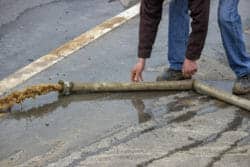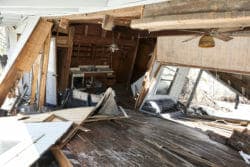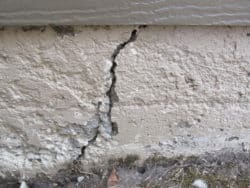Pumping Flood Water Out Of Basements Too Soon May Cause Structural Damage
Home » Structural » Basements »

Flooded basements may suffer structural damage if pumped out improperly or too soon; walls may crack or even collapse in a few cases.
Disaster relief workers, friends or sometimes local fire departments will volunteer to pump flood waters out of your basement, so be careful for they may not understand the risk.
Before pumping think about the safety
Electrical shock or electrocution
Prior to entering a basement with flood water, whether it’s 6 feet deep or 2 inches deep, be sure that you are not running a chance of getting shocked or electrocuted. Wet outlets, switches and panels are dangerous when they are energized; entering a wet basement with the power on can be deadly.
The power at the main electrical panel should be shut off and if it’s on and you’re going to shut it off, do not stand in water or on anything that is wet. Should there be electrical poles or power lines down near the house, remember, there could be stray current or energized obstacles.
Is the house and basement structurally safe?
Should there be significant damage and part of the house is not sound, then entering the basement or pumping it out should be delayed until it is safe to enter the basement. Never enter an unsafe house with severe damage and if you must, then have someone present that can call 911 in an emergency and help if something should happen.
Foundation damage from pumping out flood water too fast
Basement Walls
Right after a large flood and the basement is filled with water and the exterior soil is heavily saturated with water, the pressure on the basement wall is similar. Once you start pumping the water out of the basement and the water level is getting lower and lower, the pressure on the inside pushing on the wall is decreasing; thus, there is more and more pressure on the wall pushing inwardly.
As this pressure differential increases when pumping out water, the risk of walls cracking, bowing or collapsing increases.
Basement concrete slab
Concrete slab basement floors may also incur damage from flood waters. Hydrostatic pressure pushing up on a floor may result in cracking and damage. Additionally, a basement may be damaged from buoyant types of pressures, such as a basement that is well sealed and constructed not to leak. It tends to want to float, except all the weight on top of it (the house) holds it down, but the upward pressure is still pushing on the floor and walls which increase the chance of damage as the water in the basement is removed.

Reducing the risk of structural damage
Don’t pump the water out too quickly – FEMA guidelines
- Test the rate of water coming in by marking the wall and draw down 1 foot of water.
- Wait 24 hours.
- If the water level has not changed, draw down another foot of water and mark the new level. (If the level went back up [covered your mark] it is still too early to drain your basement)
- Wait another 24 hours.
- When the water level has remained down, begin to draw down 2-3 feet of water every 24 hours until the basement is empty.
Bracing the walls
Watch for any walls to start bowing (vertically and horizontally) or tilt inwardly. If a wall starts to slightly move or shift inwardly, then bracing the wall may help prevent or reduce damage. Running braces from one exterior wall to the opposite exterior wall usually help. Contractors may install bracing about every 6 lineal foot of wall starting at the top of the wall, and if necessary another set about 4 foot above the floor; this may vary based on circumstances.
Professional advice
If unsure if there are any risk, consulting with a structural engineer or other qualified professionals would be wise.
After pumping out a basement – Check for:
- Cracks
- Leaning or bowing walls
- Columns or post leaning or damaged
- Beams that have moved where they sit in wall sockets
- Concrete floor: cracked, damaged or not sloping toward any drains properly
- Overtime look for rust stains at cracked areas
Once the flooding is over and the basement is emptied of water, check the house for foundation damage and for other structural damage.
( Read – checklist for discovering flood damage to a foundation )
( Read – checklist for discovering flood damage to a homes’ structure on top of the foundation )
Tip: hose or wash down the basement walls as you are pumping out the dirty water. It helps make the clean-up process a little easier.

Fortunately, the majority of time basements walls do not become damaged when pumping flood waters out, however, under some circumstances they do, and it is wise to be aware of the risk and know what to watch for.
Think safety first and damage second. Although, it is important to get flood water out of a basement as soon as possible, it is wise to be cautious about not pumping it out too soon after the flooding if it is going to damage the basement walls.
Many factors play into whether pumping out flood water too quickly will damage the foundation, basement walls or other parts of the structure. The age of the home, the type of basement walls (masonry block, poured in place concrete, brick, stone, etc.), the depth of water, the soil type, as well as many other factors.









